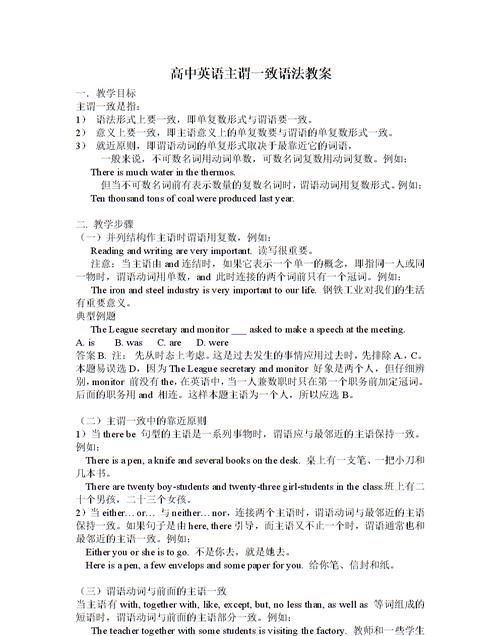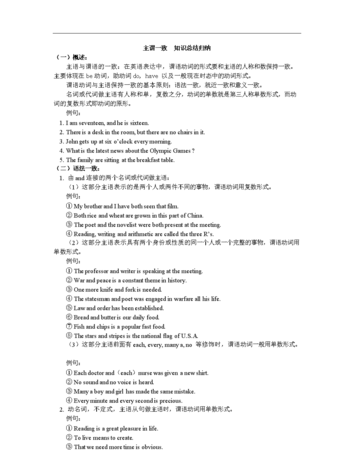本文目录
主谓一致的语法原则
概述 主谓一致指“人称”和“数”方面的一致关系。对大多数人来说,往往会在掌握主语和随后的谓语动词之间的一致问题上遇到困难。一般情况下,主谓之间的一致关系由以下三个原则的支配: 语法一致原则 (grammatical concord) 意义一致原则 (notional concord) 就近原则(principle of proximity)编辑本段典型例题 1 并列结构作主语时谓语用复数 Reading and writing are very important. 注意: 当主语由and连结时,如果它表示一个单一的概念,即指同一人或同一物时,谓语动词用单数,and 此时连接的两个词前只有一个冠词,共用一个冠词用单数,表示一人兼两职。 The iron and steel industry is very important to our life. The League secretary and monitor ___ asked to make a speech at the meeting. A. is B. was C. are D. were 答案B. 注: 先从时态上考虑.这是过去发生的事情应用过去时,先排除A.,C..本题易误选D,因为The League secretary and monitor 好象是两个人,但仔细辨别, monitor 前没有the,在英语中,当一人兼数职时只在第一个职务前加定冠词.后面的职务用and 相连.这样本题主语为一个人,所以应选B. 2 主谓一致中的就近原则 当there be 句型的主语是一系列事物时,谓语应与最邻近的主语保持一致. There is a pen, a knife and several books on the desk.. There are twenty boy-students and twenty-three girl-students in the class. 总的来说,在由not only…but also…, not just…but…, or, either…or…, neither…nor…连接主语的句子中及在there be句型中,谓语动词的单复数按就近原则处理,即按与谓语动词最靠近的那个主语来确定谓语动词的单复数形式。如: Not only John but also I am going to Shanghai next week. Either you or she is to go. Here is a pen, a few envelops and some paper for you. 3 谓语动词与前面的主语一致 当主语后面跟有with, together with, like, except, but, no less than, as well as 等词引起的短语时,谓语动词与前面的主语一致. The teacher together with some students is visiting the factory. He as well as I wants to go boating. 4 谓语需用单数 1) 代词each和由every, some, no, any等构成的复合代词作主语,或主语中含有each, every, 谓语需用单数. Each of us has a tape-recorder. There is something wrong with my watch. 2) 当主语是一本书或一条格言时,谓语动词常用单数. The Arabian Night is a book known to lovers of English. <一千零一夜>是英语爱好者熟悉的一本好书. 3) 表示金钱,时间.距离.价格或度量衡的复合名词作主语时,通常把这些名词看作一个整体,谓语一般用单数.(用复数也可,意思不变.) Three weeks was allowed for making the necessary preparations. Ten yuan is enough. 5 指代意义决定谓语的单复数 1) 在代词what, which, who, none, some, any, more, most, all等词的单复数由其指代的词的单复数决定. All is right. (一切顺利.) All are present. (所有人都到齐了.) 2) 集体名词作主语时,谓语的数要根据主语的意思来决定.如family,team,group,club,public, audience, crew, crowd, class, company, committee等词后用复数形式时,意为这个集体中的各个成员,用单数时表示该个集体. His family isn't very large. 他家不是一个大家庭. His family are music lovers. 他的家人都是音乐爱好者. 但集合名词people, police, cattle, poultry(家禽).militia(民兵).vermin(害虫)等在任何情况下都用复数形式. Are there any police around 3)有些名词,如variety, number, population, proportion, majority 等有时看作单数,有时看作复数. A number of +名词复数+复数动词. The number of +名词单数+单数动词. A number of books have lent out. The majority of the students like English. 6 与后接名词或代词保持一致 1) 用half of, part of, most of, a portion of 等词引起主语时,动词通常与of后面的名词,代词保持一致. Most of his money is spent on books. Most of the students are taking an active part in sports. 2) 在一些短语,如 many a 或 more than one 所修饰的词作主语时,谓语动词多用单数形式.但由more than… of 作主语时,动词应与其后的名词或代词保持一致. Many a person has read the novel. 许多人都读过这本书. More than 60 percent of the students are from the city.百分之六十多的学生都来自这个城市. 7 the+形容词/国籍形容词。表示一类人/一国人,作主语,谓语动词用复数。 8 the+姓氏的复数,表示一家人或两夫妇,作主语时,谓语动词用复数, 9 四则运算时,谓语动词用单数。 10 表示,(时间,距离,重量,金额,书名)的复数名词作主语时,通常当做整体看待,谓语动词用单数。
精锐老师

what什么时候作主语
如果all用于修饰名词,那么其单复数意义与所修饰的名词的单复数一致。如:
All money is spent. 所有钱都花光了。
All people are at liberty to express his opinion. 所有人都可以发表自己的意见。
all
英 [ɔːl] 美 [ɔl]
adj. 全部的
adv. 全然地;越发
n. 全部
pron. 全部
短语
fifteen all 一平 ; 十五平 ; 一比一 ; 双方各得一分
for all 尽管 ; 虽然 ; 对所有X ; 所有宝贝
all told 合计 ; 总之 ; 总共 ; 全部容

扩展资料
all作为形容词的用法
all用作形容词的基本意思是“所有的,全部的”,指两种情况:一是表示概括起来考虑的全体,此时与不可数名词或单数形式的可数名词连用; 二是表示把各部分一个一个地来看的全体,此时与复数形式的名词连用。
all 与名词连用时,在名词前可使用the〔this, that, those〕或所有格等限定词,若与复数形式的名词连用,名词前也可用基数词。
all 与 not 连用有两种含意:一为“并非…都是”; 二为“即使全部的…也不”。
与such,other等限定词连用时,all应置于其前。
all用作形容词时不用于比较等级。
英语主谓一致优秀教学设计
主谓一致即谓语动词在人称和数上要和主语保持一致,主谓一致包括语法一致、意义一致和就近一致,语法一致即谓语动词在单复数形式上要和主语保持一致,意义一致就是谓语动词要和主语意义上的单复数保持一致,就近一致就是谓语动词要和靠近它的主语部分保持一致。
主谓一致( Subject-Verb Concord )
就其在现代语法中的基本原则而言,通常有三个不同角度的着眼点:1,语法一致 2,意义一致 3,就近原则。
(1)语法一致
主谓一致的原则是指,主语和谓语从语法形式上取得一致:
主语是单数形式,谓语也采取单数形式;主语是复数形式,谓语必须采取复数形式。
例如:
A grammar book helps you learn something about the rules of a language.语法书帮助你学习语言的某些规则。(主语是单数形式,谓语也采取单数形式)
(2)不定式,动名词,以及从句作主语时应看作单数,谓语动词用单数。
例如:
Reading often means learning .读书常意味是学习。
(3)不定代词及each作主语或是修饰主语时应看作单数,谓语动词用单数。
例如:
Neither of my sisters likes sports .我的妹妹中没人喜欢运动。
(4)表示国家,机构,事件,作品等名称的专有名词作主语时应看作单数,谓语动词用单数。
例如:
One Thousand And One Nights tells people lots of mysterious bits of folklore .《一千零一夜》给人们讲了许多神秘的民间传说。
(5)a series of,a kind of,the number of等与名词构成名词短语作主语时看作单数,谓语动词用单数。
例如:
A series of high technology products has been laid out in the exhibition. 一系列高科技产品已在展览上展出。
(6)由some,several,both,few,many,a number of 等词修饰主语,或是由它们自身作主语时应看作复数,谓语动词用复数。
例如:
Both of us are fond of watching football games .我们俩都喜欢看足球赛.
(7)由and连接两个主语时,如指同一人或物,谓语用单数;指不同的人或物,谓语用复数.
On the seashore,some people are playing volleyball and some are lying in the sun. 海边,有些人在打排球,有些人躺着晒太阳.
(8)有些短语,如:a lot of,most of,any of,half of,three fifths of,eighty percent of,some of,none of,the rest of,all of等后接不可数名词,或是单数形式的名词作主语时应看作单数,谓语动词用单数;但如果后接可数名词的复数形式作主语时应看作复数,谓语动词用复数。
例如:
A lot of money in the shop was stolen yesterday when the electricity was suddenly cut off. 昨天突然断电时,那家商店丢失了许多钱.
(9)主语为单数个不定式(短语)、动名词(短语)或从句时,谓语动词一般用单数。
(10)主语为三单,或习惯用作单数名词或不可数名词的词,如:money,information,clothing等,谓语动词用单数。
意义一致(Notional Concord )
这一原则是指,从意义着眼来解决主谓一致问题.有时主语形式上为单数,但意义上却是复数,那么谓语依意义也用复数形式;而有时主语形式上为复数,但意义上却是单数,那么谓语依意义亦用单数形式。
(1)当主语后面接由as well as,as much as,accompanied by,including,in addition to,more than,no less than,rather than,together with等引导的词组时,其谓语动词的形式要依主语的单复数而定。
在这样的句子里,这些词所引导的词组不影响主语自身的单,复数形式,它们在句子里其实是状语.也就是说,我们完全可以将这些词组搬到句首或是放到句末去.从表面上我们也可以看出,它们与主语之间有","隔开。
例如:
Petroleum,along with fuel gas,has recently risen in price.目前石油和燃料煤气的价格上涨了。
(2)表示时间,金钱,距离,体积,重量,面积,数字等词语作主语时,其意义若是指总量应看作单数,谓语动词用单数;但如果其意义是指"有多少数量"则应该看作是复数,那么谓语动词也应该用复数。
例如:
Four weeks are often approximately regarded as one month.人们常大约地将四个星期看成一个月。
(3)形容词前加定冠词即"the + 形容词"作主语时,其意义若是指个人或是抽象概念应看作单数,谓语动词用单数;但如果其意义是指一类人则应该看作是复数,那么谓语动词也应该用复数。
例如:
The young,on the one hand,often think of the old conservative. On the other hand,the old always consider the young inexperience.一方面,青年人常认为老年人保守;另一方面,老年人总是认为青年人没有经验。
(4)当and连接两个并列主语在意义上指同一人,同一物,同一事或者同一概念时,应看作单数,谓语动词用单数.另外,当and 连接两个形容词去修饰一个单数形式的主语时,其实是指两种不同的事物,主语则应该看作是复数,那么谓语动词也应该用复数。
例如:
War and peace is a constant theme in history. 战争与和平是一个历史上的永恒的主题.
(5)集体名词作主语时,谓语动词的数取决于主语的意义:主语表示整体时视为单数,谓语动词用单数;主语表示集体中的个体成员时视为复数,谓语动词用复数.这类集体名词常见的有:
army,audience,cattle,class,club,committee,crowd,family,government,group,majority,minority,part,people,police,public,staff,team等等,其中cattle,people,police一般看成复数形式.
例如:
The family are all fond of football. 那一家人都喜欢足球.
就近原则(Principle of Proximity )
这一原则是指,谓语动词的人称和数常常与最近作主语的词语保持一致.常出现在这类句子中的连词有:or,either… or …,neither… nor …,not only… but also …等.例如:
Either I or they are responsible for the result of the matter.不是我,就是他们要对那件事的结局负责任。
Neither the unkind words nor the unfriendly attitude has caused me any distress.既不是那些不友好的话,也不是那不友好的态度让我沮丧。

扩展资料
1、并列结构作主语时的主谓一致
由and 连接的两个单数名词作主语时,谓语动词一般根据语法一致的原则用复数。
如:
A young man and a girl want to go there.一个青年男子和一个姑娘想去那里。
2、但如果在意义上指同一个人,同一件事或同一个概念时,谓语动词要用单数形式.如:
A needle and thread was found on the floor.在地板上找到了针线(穿了线的针)。
当each ...and each...,every...and every...,no...and no...,many a...and many a...结构作主语时,谓语动词用单数形式.
如:
No man and no animal is to be found on the moon.在月球上没发现人和动物。
3、一个单数名词同时被两个不同的形容词修饰,表示两个不同的概念时,谓语动词一
般用复数.
如:
Ancient and modern history are the subjects we are studying.古代史和现代史是我们目前学习的课程。
但如果表示的是同一概念时应用单数。
如:
The last and most difficult lesson is lesson14.14课是最后一课也是最难的一课。
4、由not only... but also ...,either...or ...,neither... nor...,... or...连接的并列主语,谓语动词通常依就近一致原则决定.
如:
Either the players or the coach is responsible for the defeat.不是运动员就是教练应该对这次比赛的失利负责。
5、当主语由as well as,along with,together with,ratherthan,no less than,but,except,besides,in additionto,like,including等词连接时,其谓语动词的单复数形式通常由前面的词来决定。
如:
An iron and steal works,with some satellite factories. is to be built here.在这里将建立一个钢铁厂和一些卫星厂。
参考资料来源:百度百科-主谓一致
初一英语主谓一致的题目
1.is
all2.
were
all指人时,动词用复数;all指物时,动词用单数.例如:
"All
are
present
and
all
is
going
well."
所有人全部到场了,一切进展顺利

以上就是关于all主谓一致语法总结 ,主谓一致的语法原则的全部内容,以及all主谓一致语法总结 的相关内容,希望能够帮到您。
